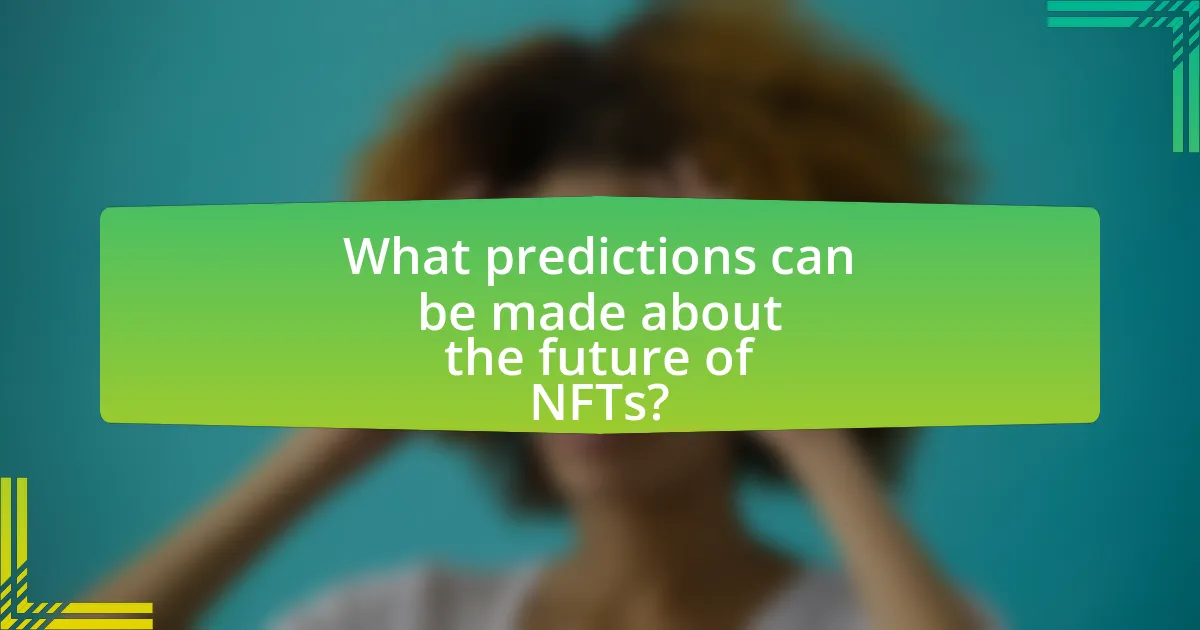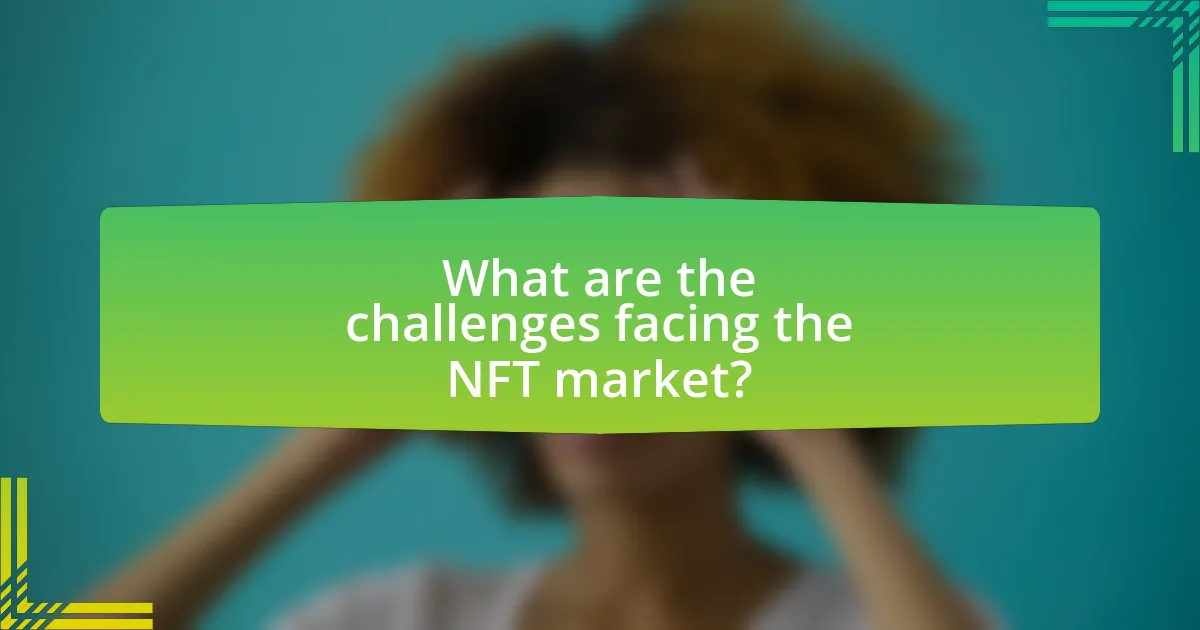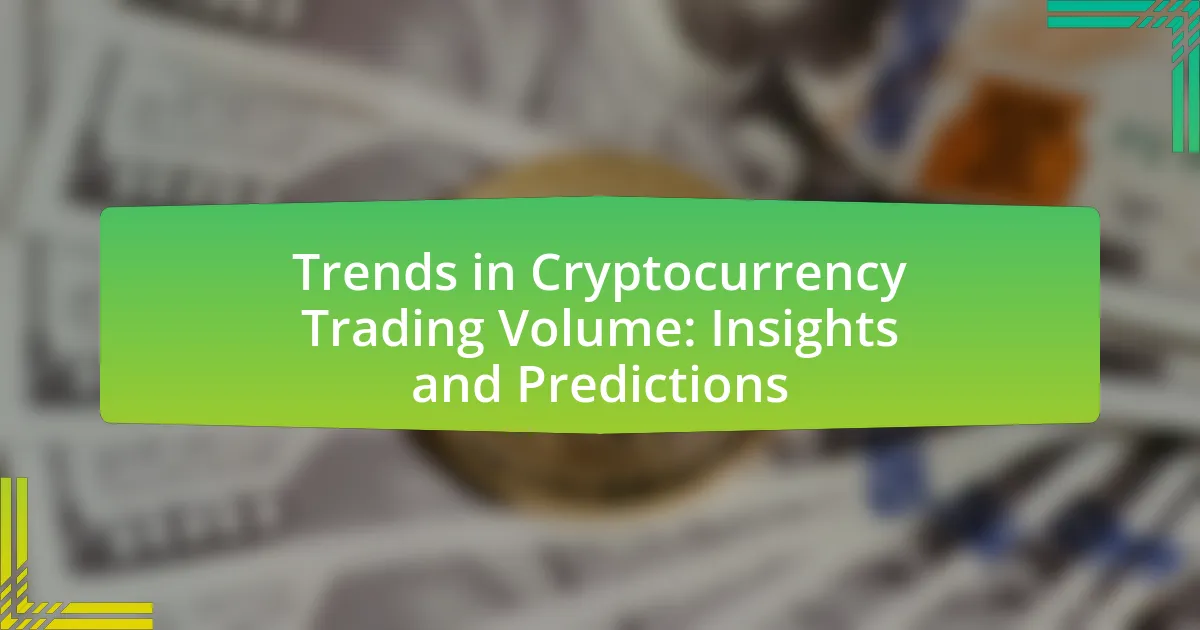The article focuses on Non-Fungible Tokens (NFTs), unique digital assets that signify ownership of specific items on a blockchain, primarily Ethereum. It explores the significance of NFTs in reshaping ownership and provenance in the digital economy, highlighting their rapid market growth, which reached $10.7 billion in 2021. Key topics include the functioning of NFTs, the technologies that support them, current market trends, and the industries rapidly adopting NFTs. Additionally, the article addresses challenges such as regulatory uncertainty, market volatility, and ethical considerations, while providing insights into future predictions and strategies for creators and investors in the evolving NFT landscape.

What are NFTs and why are they significant for the future?
NFTs, or Non-Fungible Tokens, are unique digital assets that represent ownership of a specific item or piece of content on a blockchain, primarily Ethereum. Their significance for the future lies in their ability to revolutionize ownership and provenance in the digital realm, enabling artists, musicians, and creators to monetize their work directly while ensuring authenticity and scarcity. According to a report by NonFungible.com, the NFT market reached a valuation of $10.7 billion in 2021, highlighting its rapid growth and potential for further expansion. This trend indicates that NFTs could reshape industries such as art, gaming, and real estate by providing new revenue streams and enhancing user engagement through verifiable ownership.
How do NFTs function within the digital economy?
NFTs function within the digital economy as unique digital assets that represent ownership of specific items or content on a blockchain. They enable creators to monetize digital art, music, and other forms of media by providing proof of authenticity and ownership, which is crucial in a market where digital goods can be easily replicated. The market for NFTs has seen significant growth, with sales reaching over $10 billion in 2021, demonstrating their increasing acceptance and integration into various sectors, including art, gaming, and virtual real estate. This growth indicates that NFTs are reshaping traditional economic models by allowing direct transactions between creators and consumers, bypassing intermediaries.
What technologies underpin the operation of NFTs?
The operation of NFTs is primarily underpinned by blockchain technology, specifically Ethereum, which enables the creation, ownership, and transfer of digital assets through smart contracts. Blockchain provides a decentralized ledger that ensures the authenticity and provenance of NFTs, making them unique and verifiable. Ethereum’s ERC-721 and ERC-1155 standards define how NFTs are structured and interact within the ecosystem, allowing for diverse applications beyond simple ownership, such as gaming and digital art. The use of cryptographic techniques further secures transactions and ownership rights, reinforcing the integrity of NFT operations.
How do NFTs differ from traditional assets?
NFTs differ from traditional assets primarily in their digital nature and uniqueness. Unlike traditional assets, which can be fungible and easily exchanged (such as stocks or currencies), NFTs are non-fungible tokens that represent ownership of a specific digital item or piece of content, making each NFT unique and irreplaceable. This uniqueness is secured through blockchain technology, which provides a transparent and immutable record of ownership. For example, while one share of a company is identical to another share, each NFT can represent a distinct artwork, music file, or virtual real estate, thus creating a different value proposition in the market.
What trends are currently shaping the NFT market?
Current trends shaping the NFT market include increased institutional investment, the rise of utility-based NFTs, and the integration of NFTs into gaming and metaverse platforms. Institutional investment has surged, with companies like Visa and Mastercard entering the space, indicating growing mainstream acceptance. Utility-based NFTs are gaining traction as they offer real-world applications, such as access to exclusive content or events, enhancing their value beyond mere collectibles. Additionally, the gaming industry is increasingly adopting NFTs, allowing players to own in-game assets, which has led to a significant increase in user engagement and revenue generation. These trends reflect a shift towards a more sustainable and integrated NFT ecosystem.
Which industries are adopting NFTs at a rapid pace?
The gaming, art, music, and fashion industries are adopting NFTs at a rapid pace. In the gaming sector, companies like Ubisoft and Epic Games are integrating NFTs to enhance player ownership and in-game economies. The art world has seen significant engagement, with platforms like OpenSea facilitating sales of digital art as NFTs, leading to record-breaking auction prices. In music, artists such as Grimes and Kings of Leon have released NFT albums, allowing for new revenue streams and fan engagement. The fashion industry is also exploring NFTs, with brands like Gucci and Prada launching digital collectibles, reflecting a shift towards virtual fashion experiences. These trends indicate a broader acceptance and integration of NFTs across diverse sectors.
How are consumer behaviors influencing NFT trends?
Consumer behaviors are significantly influencing NFT trends by driving demand for unique digital assets and shaping market dynamics. As more individuals seek ownership of exclusive digital items, the popularity of NFTs has surged, evidenced by a 2021 report from NonFungible.com indicating a 21,000% increase in NFT sales compared to the previous year. This consumer interest is further reflected in the rise of community-driven projects and social media engagement, where buyers prioritize authenticity and connection to creators. Additionally, the growing acceptance of NFTs in mainstream culture, highlighted by high-profile endorsements and collaborations, has led to increased consumer participation, thereby shaping the evolving landscape of the NFT market.

What predictions can be made about the future of NFTs?
The future of NFTs is predicted to see increased mainstream adoption across various industries, including art, gaming, and real estate. As of 2023, the NFT market has shown resilience, with a growing number of brands and creators leveraging NFTs for digital ownership and engagement. Reports indicate that the global NFT market size is expected to reach approximately $231 billion by 2030, driven by advancements in blockchain technology and the integration of NFTs into social media platforms. Additionally, regulatory frameworks are anticipated to evolve, providing clearer guidelines that could enhance investor confidence and market stability.
How might regulatory changes impact the NFT landscape?
Regulatory changes could significantly reshape the NFT landscape by introducing compliance requirements that affect how NFTs are created, bought, and sold. For instance, regulations may mandate that NFT platforms implement Know Your Customer (KYC) and Anti-Money Laundering (AML) procedures, which could limit anonymity and increase operational costs for creators and platforms. Additionally, changes in intellectual property laws could clarify ownership rights, impacting how NFTs are marketed and traded. Historical examples, such as the introduction of the General Data Protection Regulation (GDPR) in Europe, demonstrate how regulatory frameworks can alter digital markets by imposing strict data handling and privacy requirements, thereby influencing user engagement and platform operations.
What potential legal challenges could arise for NFTs?
Potential legal challenges for NFTs include copyright infringement, fraud, and regulatory compliance issues. Copyright infringement can arise when NFT creators use copyrighted material without permission, leading to legal disputes over ownership and rights. Fraud can occur if sellers misrepresent the authenticity or value of an NFT, resulting in potential lawsuits from buyers. Regulatory compliance issues may emerge as governments develop new laws regarding digital assets, which could affect how NFTs are classified and taxed. For instance, the U.S. Securities and Exchange Commission has indicated that some NFTs may be considered securities, which would subject them to stricter regulations.
How can creators and investors prepare for regulatory shifts?
Creators and investors can prepare for regulatory shifts by staying informed about current regulations and engaging with legal experts. Regularly monitoring updates from regulatory bodies, such as the SEC or CFTC, helps in understanding potential changes that could impact the NFT market. Additionally, participating in industry forums and discussions can provide insights into emerging trends and regulatory concerns. For instance, the rapid evolution of regulations around digital assets, as seen in the European Union’s MiCA framework, highlights the importance of proactive adaptation. By establishing compliance protocols and diversifying investments, creators and investors can mitigate risks associated with regulatory changes.
What technological advancements could enhance NFTs?
Technological advancements such as improved blockchain scalability, interoperability between different blockchain networks, and enhanced smart contract functionalities could significantly enhance NFTs. Improved blockchain scalability, exemplified by solutions like Ethereum 2.0, allows for faster transaction speeds and lower fees, making NFT transactions more efficient. Interoperability, facilitated by protocols like Polkadot, enables NFTs to be utilized across various platforms, increasing their utility and market reach. Enhanced smart contract functionalities, through developments in programming languages like Solidity, allow for more complex and customizable NFT features, such as dynamic pricing and royalties, which can attract more creators and collectors to the NFT space.
How might blockchain technology evolve to support NFTs?
Blockchain technology may evolve to support NFTs by enhancing scalability, interoperability, and energy efficiency. As demand for NFTs increases, blockchain networks are likely to implement layer-2 solutions, such as rollups, to process transactions more efficiently, thereby reducing congestion and lowering fees. Additionally, cross-chain protocols could emerge, allowing NFTs to be transferred seamlessly between different blockchain ecosystems, which would expand their usability and market reach. Furthermore, advancements in consensus mechanisms, such as proof-of-stake, can lead to more energy-efficient operations, addressing environmental concerns associated with NFT minting and trading. These developments are supported by ongoing research and initiatives within the blockchain community aimed at improving infrastructure and user experience.
What role will interoperability play in the future of NFTs?
Interoperability will be crucial for the future of NFTs as it enables seamless interaction across different blockchain platforms. This capability allows users to transfer and utilize their NFTs across various ecosystems, enhancing their utility and value. For instance, projects like Ethereum and Polygon are already exploring cross-chain compatibility, which can lead to a more integrated digital asset landscape. Furthermore, a report by NonFungible.com indicates that interoperability can drive market growth by increasing user engagement and expanding the potential applications of NFTs in gaming, art, and virtual real estate.

What are the challenges facing the NFT market?
The NFT market faces several challenges, including regulatory uncertainty, market volatility, and environmental concerns. Regulatory uncertainty arises as governments worldwide grapple with how to classify and regulate NFTs, leading to potential legal complications for creators and investors. Market volatility is evident in the fluctuating prices of NFTs, which can deter new participants and create instability. Environmental concerns stem from the energy-intensive processes associated with blockchain technology, particularly proof-of-work systems, which have drawn criticism for their carbon footprint. These challenges collectively hinder the growth and mainstream adoption of NFTs.
How does market volatility affect NFT investments?
Market volatility significantly impacts NFT investments by influencing their prices and investor sentiment. During periods of high volatility, NFT prices can fluctuate dramatically, leading to increased risk for investors. For instance, in early 2022, the NFT market experienced a downturn, with sales volume dropping by over 50% compared to the previous year, reflecting how market conditions can directly affect investment values. Additionally, investor confidence tends to wane during volatile periods, resulting in reduced demand for NFTs, which further exacerbates price declines. Thus, market volatility creates an environment where NFT investments can be highly unpredictable and subject to rapid changes in value.
What strategies can investors use to mitigate risks?
Investors can mitigate risks by diversifying their portfolios across various asset classes, including NFTs, cryptocurrencies, stocks, and bonds. Diversification reduces the impact of a poor-performing asset on the overall portfolio, as different assets often react differently to market conditions. For instance, during market downturns, traditional assets like bonds may provide stability while NFTs could experience volatility. Historical data shows that diversified portfolios tend to yield more consistent returns over time, as evidenced by studies from financial institutions like Vanguard, which indicate that diversification can lower risk without sacrificing returns.
How can creators ensure the longevity of their NFT projects?
Creators can ensure the longevity of their NFT projects by fostering community engagement and continuously providing value to their audience. Engaging with the community through regular updates, interactive events, and feedback loops helps maintain interest and loyalty among collectors. Additionally, offering utility, such as exclusive access to events or future drops, enhances the perceived value of the NFTs. Historical examples, such as the success of projects like Bored Ape Yacht Club, demonstrate that strong community ties and added benefits contribute significantly to the sustained interest and market value of NFTs.
What ethical considerations should be addressed in the NFT space?
The ethical considerations that should be addressed in the NFT space include issues of copyright infringement, environmental impact, and market manipulation. Copyright infringement arises when creators’ works are tokenized without their consent, leading to potential legal disputes and loss of revenue for original artists. The environmental impact is significant, as many NFTs are minted on energy-intensive blockchains, contributing to carbon emissions; for instance, the Ethereum network’s energy consumption has been compared to that of entire countries. Market manipulation can occur through practices such as wash trading, where sellers artificially inflate prices, undermining the integrity of the market. Addressing these ethical concerns is crucial for fostering a sustainable and fair NFT ecosystem.
How can environmental concerns be mitigated in NFT production?
Environmental concerns in NFT production can be mitigated by transitioning to energy-efficient blockchain technologies, such as proof-of-stake systems. These systems significantly reduce energy consumption compared to traditional proof-of-work models, which require extensive computational power. For instance, Ethereum’s transition to proof-of-stake has been reported to decrease energy usage by approximately 99.95%, according to the Ethereum Foundation. Additionally, utilizing carbon offsetting strategies, such as investing in renewable energy projects, can further alleviate the environmental impact associated with NFT transactions.
What measures can be taken to prevent fraud in the NFT market?
To prevent fraud in the NFT market, implementing robust verification processes is essential. These processes include using blockchain technology to authenticate ownership and provenance, ensuring that each NFT’s history is transparent and traceable. Additionally, platforms should enforce strict Know Your Customer (KYC) regulations to verify the identities of users, reducing the risk of anonymous fraudulent activities. According to a report by Chainalysis, over $7.7 billion was lost to scams in the cryptocurrency space in 2021, highlighting the need for enhanced security measures. Furthermore, educating users about common scams and promoting best practices for safe transactions can significantly mitigate risks.
What practical steps can individuals take to engage with NFTs effectively?
Individuals can engage with NFTs effectively by first educating themselves about blockchain technology and the NFT marketplace. Understanding how NFTs function, including their creation, buying, and selling processes, is crucial. Next, individuals should create a digital wallet compatible with NFTs, which allows them to store and manage their digital assets securely.
After setting up a wallet, individuals can explore various NFT platforms, such as OpenSea or Rarible, to discover and purchase NFTs that align with their interests. Participating in NFT communities on social media platforms like Twitter and Discord can provide insights and networking opportunities.
Additionally, individuals should consider creating their own NFTs by leveraging platforms that facilitate minting, which can enhance their engagement in the space. Staying updated on market trends and participating in auctions or drops can also help individuals make informed decisions.
These steps are supported by the rapid growth of the NFT market, which reached a valuation of approximately $41 billion in 2021, indicating a significant interest and potential for individuals to engage meaningfully.
How can newcomers safely navigate the NFT marketplace?
Newcomers can safely navigate the NFT marketplace by conducting thorough research, using reputable platforms, and ensuring secure transactions. Researching involves understanding the types of NFTs, the technology behind them, and the market trends, which can be done through resources like NFT marketplaces, forums, and educational content. Utilizing reputable platforms, such as OpenSea or Rarible, minimizes the risk of scams, as these platforms have established security measures and user reviews. Additionally, newcomers should prioritize secure transactions by using wallets with strong security features, enabling two-factor authentication, and being cautious of phishing attempts. According to a report by NonFungible.com, the NFT market has seen significant growth, with a 300% increase in sales volume from 2020 to 2021, highlighting the importance of informed participation in this evolving space.
What best practices should creators follow when launching NFTs?
Creators should prioritize community engagement and transparency when launching NFTs. Engaging with potential buyers through social media and forums fosters a loyal community, which is crucial for the success of NFT projects. Transparency about the project’s goals, the technology used, and the distribution process builds trust and encourages participation. Additionally, creators should ensure their NFTs are unique and provide value, whether through artistic merit, utility, or exclusivity. According to a report by NonFungible.com, successful NFT projects often have a strong narrative and clear utility, which enhances their appeal and marketability.






